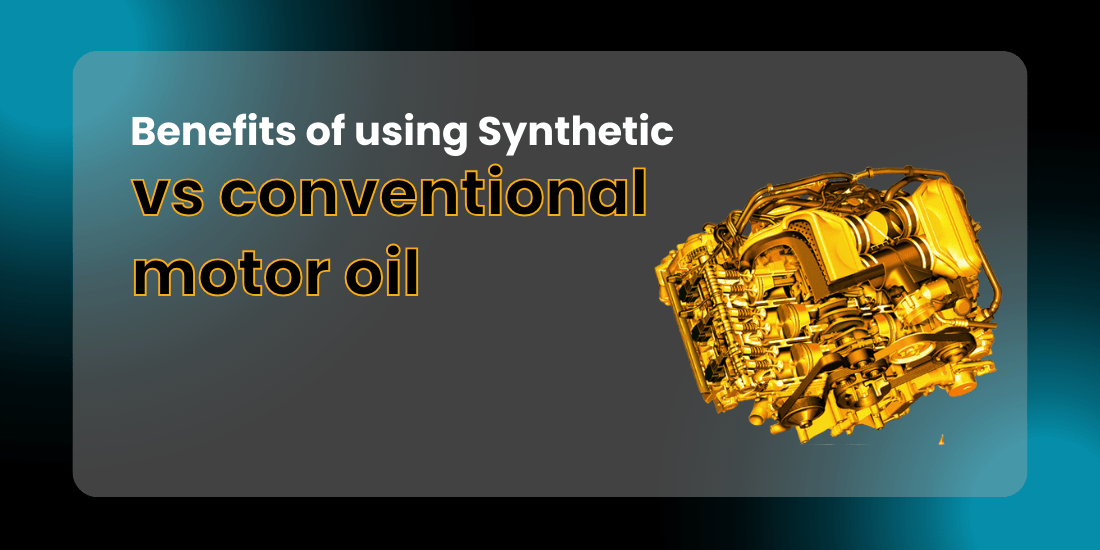Conventional Motor Oil
Synthetic Motor Oil
Key Differences
While both synthetic and conventional engine oils share the primary function of lubricating engine parts, they diverge in their composition and manufacturing processes. Beyond lubrication, these oils provide essential functions such as:
- Protecting engine parts against wear and tear
- Mitigating water damage and corrosion
- Preventing the formation of engine sludge
- Eliminating and preventing the accumulation of dirt and impurities in the engine
- Facilitating the cooling of engine parts, particularly under high-temperature conditions
- Transmitting engine torque to maximize horsepower
Despite these common functions, synthetic and conventional engine oils exhibit differences rooted in their production methods, chemical compositions, and performance characteristics. The choice between them depends on factors like driving conditions, vehicle specifications, and personal preferences.
How They’re Made
1. Synthetic Oil Production Process
2. Conventional Oil Production Process
Understanding Oil Viscosity Index
The Oil Viscosity Index (VI) is a crucial factor distinguishing conventional and synthetic oils. Conventional oils typically have a VI ranging from 95 to 100, while synthetic oils boast a significantly higher VI, often exceeding 120.
The elevated viscosity index of synthetic oils stems from their unique additives. These additives enhance the oil’s molecular structure, allowing it to maintain a stable viscosity across a broad temperature range. The superior VI of synthetic oils makes them particularly resilient under extreme conditions, effectively resisting viscosity changes caused by high temperatures and pressures.
However, it’s essential to note that not all synthetic oils are suitable for every temperature condition. The American Petroleum Institute (API) label on motor oil bottles serves as a valuable guide. This label provides detailed information about the oil’s viscosity and performance index, aiding consumers in selecting the right synthetic oil tailored to their specific driving conditions. Understanding the VI becomes paramount in ensuring optimal engine protection and performance across diverse temperature scenarios.
Pricing Differences in Motor Oil Options
When it comes to the cost of engine oils, there are significant variations based on the type of oil you choose. Conventional motor oil, also known as mineral oil, stands out as the most budget-friendly option. For instance, five quarts of conventional oil typically cost around $28.
On the other end of the spectrum, fully synthetic oil comes with a higher price tag, ranging from two to four times more than its conventional counterpart. Investing in five quarts of synthetic oil can set you back around $45. The increased cost of synthetic oil is attributed to the advanced technology and equipment required in its production.
Due to the higher expense associated with fully synthetic oil changes, many car owners opt for a middle ground – synthetic blend motor oil, also known as semi-synthetic oil. This option combines the benefits of fully synthetic and conventional oils at a more affordable price point. Despite being less costly than fully synthetic oil, a synthetic blend outperforms mineral oil and serves as a transitional step for those considering a switch to full synthetic. Choosing the right oil for your vehicle involves considering both performance and budgetary factors.
D. Comprehensive Analysis of Oil Change Intervals
Synthetic Oil
Conventional Oil
In contrast, conventional oil necessitates more frequent oil changes when compared to full synthetic and synthetic blend oils. The typical oil change interval for conventional oil ranges between 3,000-5,000 miles. In optimal conditions, it may stretch to around 7,000 miles before requiring a change.
It’s essential to pay attention to signs of deteriorating motor oil as you approach or exceed the recommended oil change interval. Dark, muddy oil with suspended impurities indicates that the oil has surpassed its effectiveness.
The Advantages of Synthetic vs. Conventional Motor Oil
1. Benefits of Synthetic Oil
- Excellent engine protection in extreme temperatures.
- Fewer emissions compared to regular oil.
- Longer intervals between oil changes.
- Enhanced engine protection due to higher viscosity and fewer impurities.
- Greater resistance to oil thickening.
- Improved stability in both low and high temperatures.
- Maximized horsepower with high friction resistance.
- Better gas mileage.
Potential Disadvantages
- Higher costs (offset by longer change intervals).
- Possible additive separation in cold storage.
- Slightly lower gas mileage at highway speeds.
2. Benefits of Conventional Oil
- More cost-effective than synthetic or synthetic blend oil.
- Affordable oil change intervals.
- Suited for older engines requiring thicker oil viscosity.
- Less likely to cause leakage and engine wear in older cars.
Downsides
- Prone to oxidation and degradation.
- Poor performance in cold temperatures.
- May collect sludge in new vehicles.
- Involves a highly toxic extraction process.
Choosing the Right Engine Oil
1. Synthetic oil
- Ideal for modern engines, especially turbocharged ones.
- Suitable if driving involves long distances or frequent towing.
- Recommended for extreme hot or cold temperatures.
- Beneficial for new vehicles with turbocharged engines.
2. Conventional oil
- More suitable for older engines, but switching to synthetic is possible.
- Not the best option for engines with low performance requirements.
- Consider older cars with high mileage or poor maintenance.
Consider Alternating or Using Synthetic Blend
- Alternating between synthetic and conventional oil is an option.
- Synthetic blend offers a cost-effective and performance-enhancing middle ground.
Remember to Consult Your Vehicle’s Manual for the Right Choice.
Conclusion
The choice between synthetic and conventional motor oil is nuanced, considering factors such as composition, pricing, and oil change intervals. Synthetic oil offers advanced performance, longer change intervals, and suitability for modern engines. On the other hand, conventional oil provides a cost-effective option for short-term budgets and older engines.
Understanding the distinctions in oil composition, viscosity index, and pricing helps car owners make informed decisions. Whether prioritizing long-term cost efficiency or immediate budget concerns, the right choice depends on individual driving habits and vehicle specifications.
Ultimately, consulting your vehicle’s manual is crucial for personalized guidance on selecting the optimal engine oil. It ensures that your choice aligns with the specific needs of your car, promoting longevity, efficiency, and overall engine health.

